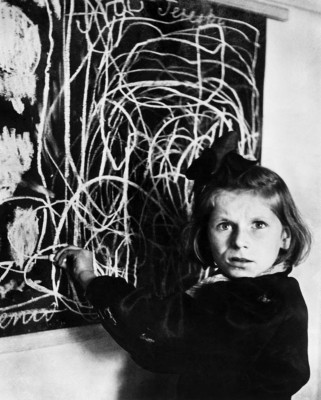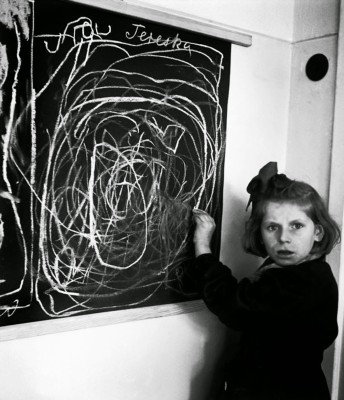
Tereszka, a child in a residence for disturbed children. She drew a picture of “home” on the blackboard. Poland, 1948.
A girl who grew up in a concentration camp was asked to draw “home” and what she drew was scribbles. It shows how the horrors of the concentration camp warped her mind. It’s a mystery what the lines truly mean to her, probably the chaos or the barbed wire.
This photograph was taken by Chim (David Seymour) in a home for emotionally disturbed children located in Warsaw, 1948. There are a few versions of this image, but most of the captions (including one at the War/Photography Exhibit currently on view at the Brooklyn Museum) mention that the subject grew up inside a concentration camp.
There’s little information about the girl’s identity, her name was Tereszka, a diminutive version of Teresa. Her eyes are piercing, like a window to her soul. Not the eyes of an innocent youth. She’s probably experienced horrors at that age most will fortunately never have to. Like the soldiers who have seen heavy combat, she’s got the terrifyingly haunting one thousand yard stare.
Most children who survived the Holocaust emerged from hiding places – attics and cellars, caves and forests, convents and monasteries, and homes ranging from huts to castles. When the war in Europe ended in May 1945, more than 1 million and perhaps as many as 1.5 million Jewish children were dead, targeted victims in the Nazis’ calculated program of genocide.
Of the estimated 216,000 Jewish youngsters deported to Auschwitz, only 6,700 teenagers were selected for forced labor; nearly all the others were sent directly to the gas chambers. When the camp was liberated on January 27, 1945, Soviet troops found just 451 Jewish children among the 9,000 surviving prisoners.
Liberation for children was not necessarily liberating. Mostly, parents did not come for them. Children waited for years until hope too had died. The youngest survivors did not know their names, country of origin, or even their first language. The older ones faced untold hardships and, for most, 3-5 years more passed before they had found a home. Children were swept up from Europe and resettled in England and Israel, the United States and Canada, Australia and South Africa.
Their experiences were very different from the older survivors. Generally speaking, those under age 16 or 17, by war’s end, were taken in by foster families, returned to school, and discouraged to speak of the past.
(Photo credit: David Seymour, 1948)
